Table of Contents
This article may contain compensated links. Please read Disclaimer for more info. As an Amazon Associate, I earn from qualifying purchases.
Introduction
Finding and collecting art is a thrill. There is a charming sense of accomplishment in owning a piece of art you love. Yet collecting only brings you halfway, since you still have to hang the picture up on the wall to really enjoy it.
Are you wondering how to hang your newly acquired pictures? Do some old pictures get dusty in your storage because you are lacking some ideas on how to hang pictures? Overwhelmed when trying to follow all conventional rules for hanging art or the insights of popular design gurus talking about the best way to hang pictures? Then this guide is for you.
We believe that the real art of hanging art, following interior design rules, and finding the proper height to hang pictures lies in striking a balance when structuring your spaces. This means evaluating which interior design rules are predominantly relevant for your wall and how to skillfully break the rules if it makes sense. Let’s have a look at the conventions of interior decoration first:
- Match artwork shape to wall shape
- Height to hang pictures at eye level
- Maintain constant space between pictures
- Use a unifying theme for collages
- Artwork should be 2/3 width of furniture
- Hang art 15 cm to 25 cm above furniture
As with every aspect of design, understanding the basic principles first is helpful to then improvise. Oftentimes, the most attractive arrangement is the one least expected.
Hanging Art: Concept of Negative and Positive Space
Before we look at each rule, let us first consider the basic theory of positive and negative space. The concept stems from the field of fine arts, where the positive space-negative space duality plays an important role in composing a piece of art. Simply put, positive space is the area in a work of art that complements the subjects of interest, while negative space is the area around these subjects. While positive space is usually the focus area, negative space is just as important. Together they define outlines, create rhythm, and proportion.
Artists like M. C. Escher have used the effects and the rhythm of positive and negative space to create optical illusions:
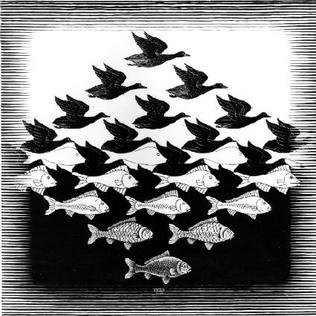
Applied to home interior design and hanging wall art, the negative spaces are the unfilled areas in the room and the bare wall, while the positive space includes wall art, windows, furniture, and the like, constituting focal points within that negative space. You can become more successful in “composing” your rooms by considering both kinds of spaces in your home styling. Negative space is much more prominent in minimalist interior design, which emphasizes empty areas; however, maximalist design concepts likewise require negative space to be successful. Rules 1. to 6. about how to hang artwork listed above all rely on balancing negative and positive space, creating a rhythm that is pleasant to the eye.
The six Conventions of Interior Decoration
Match artwork shape to wall shape
You are wondering how to hang a large canvas piece or a small photographic art on the wall? A safe way of choosing decor art for your home is to first consider the shape of the free space (negative space) on the wall. Like attracts the like, meaning, for example, that a high vertical wall space will be suitable for a large picture in portrait format, or a wide horizontal spot above a long sofa will be just right for a broad artwork in landscape format.
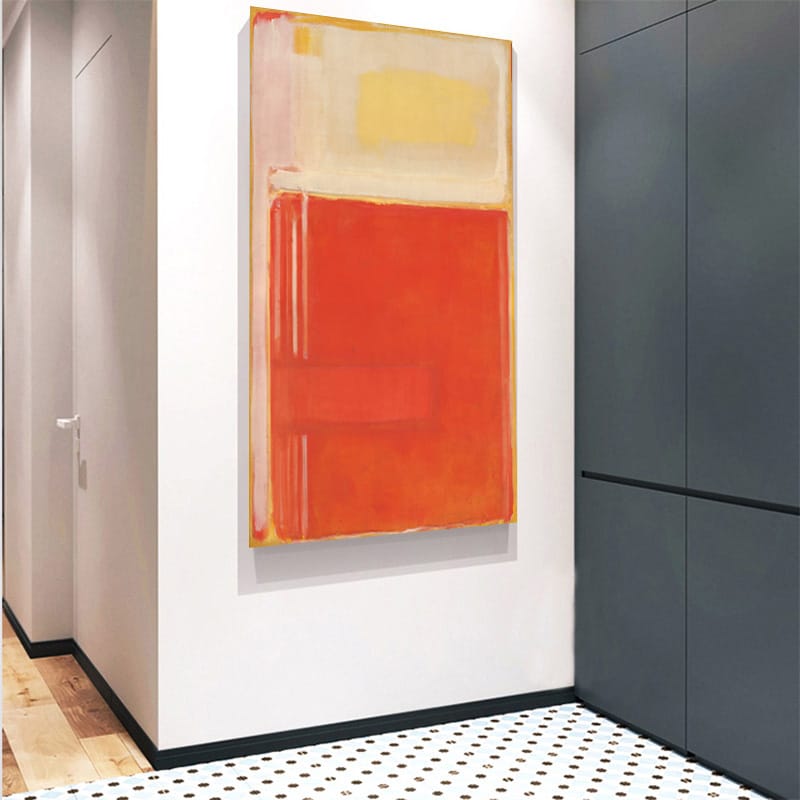
You can break this rule … if you want to hang art in a different way: Put up several pictures instead of one by mixing and matching. When you hang wall art in groups of two or more pictures or you want to hang a gallery, you achieve a balanced composition of positive and negative space by imagining the composition of pictures to be a single piece. Use the same type of frames and white mats for grouping together your pictures to create the illusion of one large size horizontal or vertical piece.
When hanging paintings, a smaller piece of art can also be impactful for a large wall space as long as it is particularly eye-catching and beautifully framed.
Height to hang pictures at eye level
Regarding precise positioning, home design has adopted museum and gallery conventions as for picture hanging guidelines: The height to hang art should be at eye level. According to the gallery height for hanging art, the midpoint of a piece of art should be around 165 cm from the floor. Once the exact midpoint is chosen, try to stick to it throughout the entire apartment for consistency. For a grouping of artwork, you can envision the entire collection as one piece of art.
To get the right height for your nail or screw, find the middle of the wall from side to side and then measure the height of 165 cm from the ground. Where the two points meet, this should be the middle of your artwork. Now, measure the distance between the middle of the artwork and where it will catch the nail. Finally, measure that difference from your mid-point mark on the wall upwards: This is where the nail or wall anchor will go.
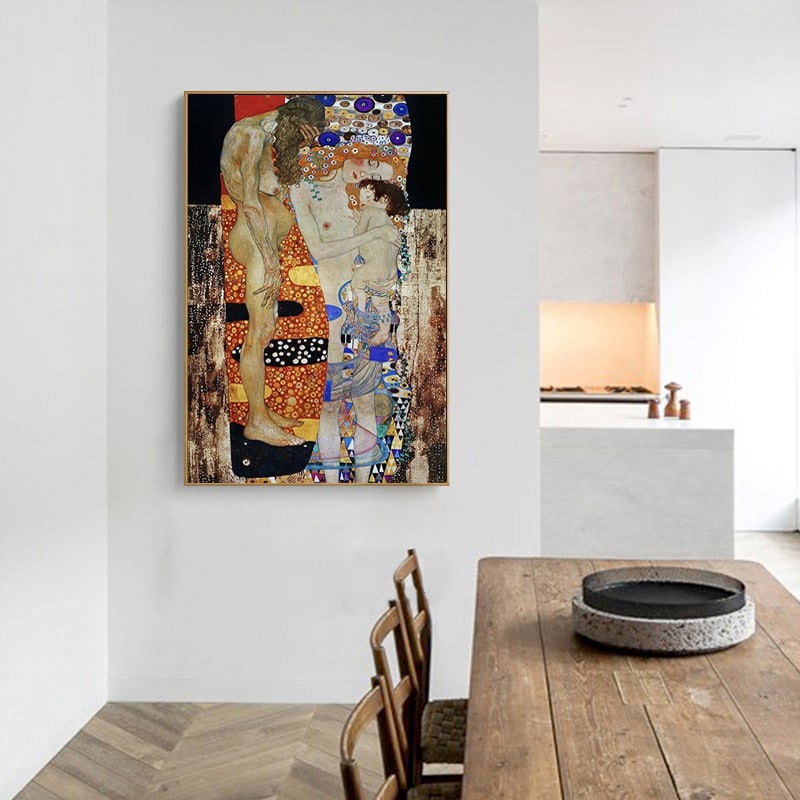
You can break the picture hang height rule … since there are many good reasons to hang pieces below or above the “correct” height to hang pictures. In any setting, it will be necessary to react to the room architecture, the furniture, and, probably most importantly, to your own preferences and instincts. Refreshing effects can be achieved through unconventional placements, e.g., by hanging a little art piece above the door, hanging several small pictures low above a desk, or making a living room cosier by lowering a picture over a sofa. The proper height to hang art can be altered in the dining room, where wall art can be slightly lower than eye level since you will enjoy looking at it most while sitting down.
It further makes sense to adapt the eye level rule if ceilings are very low or exceptionally high. Here a good rule of thumb would be to divide the wall vertically into four equal sections and placing the artwork in the third quadrant counting from the floor.
Maintain constant space between pictures
How to hang pictures if you want to integrate multiple paintings on a wall? When hanging several pieces of art on one wall, the entire collection is generally considered as if it was one single work of art: Hanging the composition around an eye-level focal point will be helpful to have it appear balanced. How to arrange pictures on a wall? Interior design rules dictate to keep the negative space between two artworks at a maximum of 15 cm apart. The best way to hang pictures will usually be with a 5 to 8 cm distance in between.
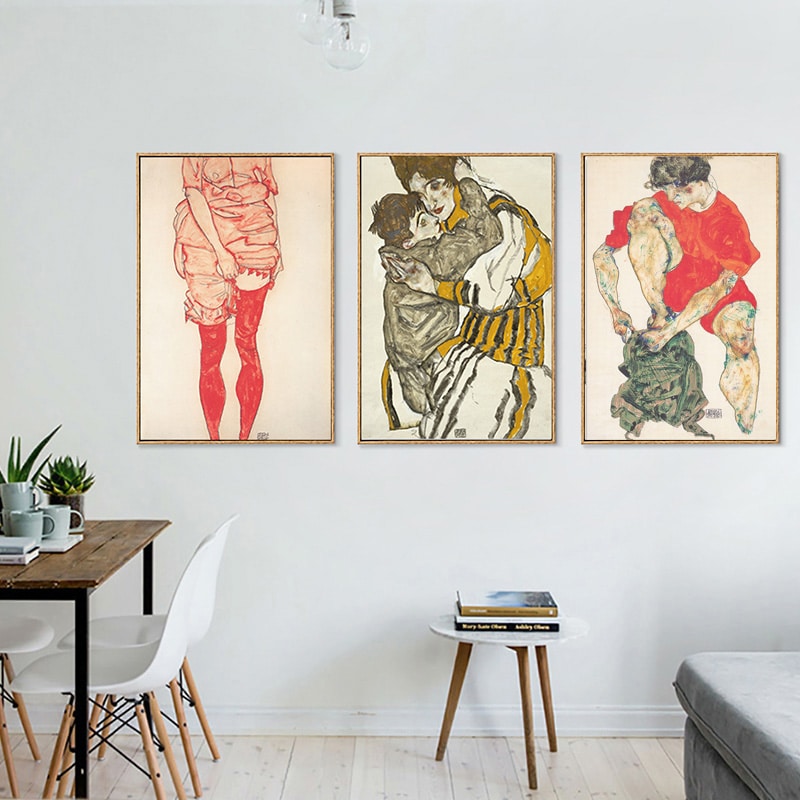
You can break the spacing rule… when hanging an eclectic grouping of pictures of strong individuality. Let your intuition speak when looking for ideas on how to hang pictures. If hanging art in threes, for example in a hallway or in a vertical orientation on a high wall, the spacing can further be adjusted according to the size of the negative space and your personal preferences.
Use a unifying theme for collages
How to hang a collageCollage refers to an art form where different materials are combined to create a single artwork. This technique often uses paper, fabric, photographs, and other found objects. It brings diverse elements together in a visually engaging way. History and Origin The concept of collage dates back to ancient times. Early cultures used materials like gold leaf and fabric in their More of pictures? In many groupings, a common thread will be helpful for tying pieces of wall art together. For example, pictures can be part of a set or a collection; if this is not the case, you can choose the same style of frames and mats of the same colour to make the collection appear cohesive. You can use a colour palette generator for inspiration.
Break this rule of how to arrange a collageCollage refers to an art form where different materials are combined to create a single artwork. This technique often uses paper, fabric, photographs, and other found objects. It brings diverse elements together in a visually engaging way. History and Origin The concept of collage dates back to ancient times. Early cultures used materials like gold leaf and fabric in their More of pictures on a wall … if you intentionally want to emphasize the diversity of images chosen. In this case, the grouping of wall art might not need a linking element or a particular picture hanging kit, the only unifying theme being its miscellany. However, collections like these should be well considered. Your picture frame hanging of this kind might take a little more nerve and is best suited for less formal rooms.
While it is tempting to keep a certain symmetry when hanging your pictures, sometimes the opposite brings the best results. A good balance can also be found when hanging a frame slightly off-centre for some extra dynamic feel.
Artwork should be 2/3 width of furniture
When hanging art over furniture, such as a sofa, a bed, or a fireplace, the general rule calls for a piece of art 2/3 to 3/4 of the width of the furniture.
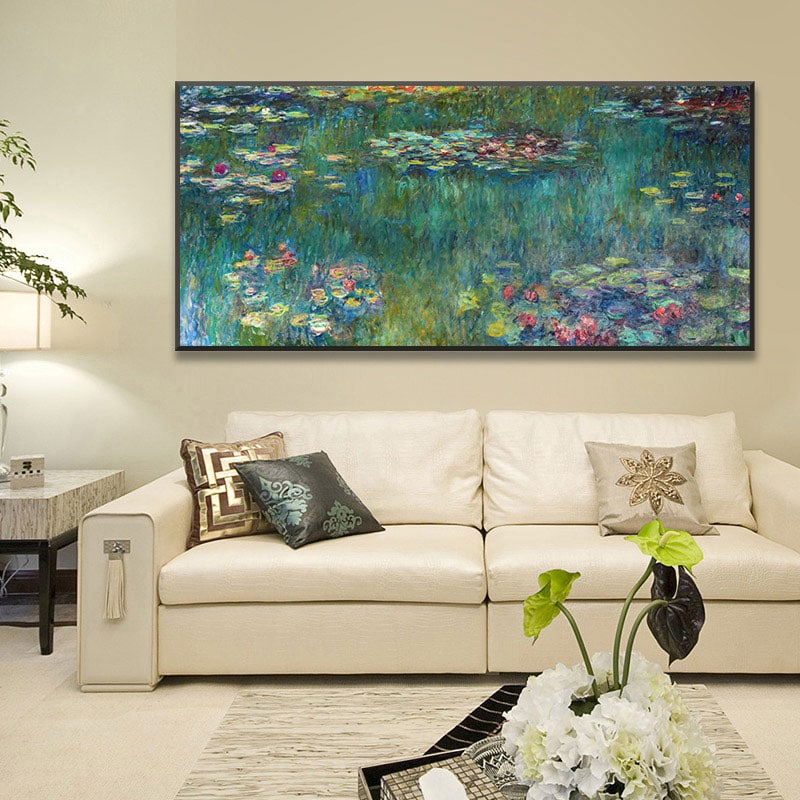
Break this rule … when you want to hang a grouping of pictures. Consider the collection of wall art as one single piece and start with the centrepiece when setting it up. Groupings in odd numbers work best when considering how to arrange pictures on a wall. For example, perfect your sofa wall by hanging art in threes choosing art tall or narrow to achieve some volume without appearing crowded.
Hang art 15 cm to 25 cm above furniture
How high to hang pictures over a sofa and other items? As mentioned above, there is no need for hanging pictures at eye level when placing them above furniture, such as sofas or tables, above mantles, or other obstructions. In this case, designers determine the height to hang pictures conventionally 15 to 25 cm from the top of the feature to the picture frame.
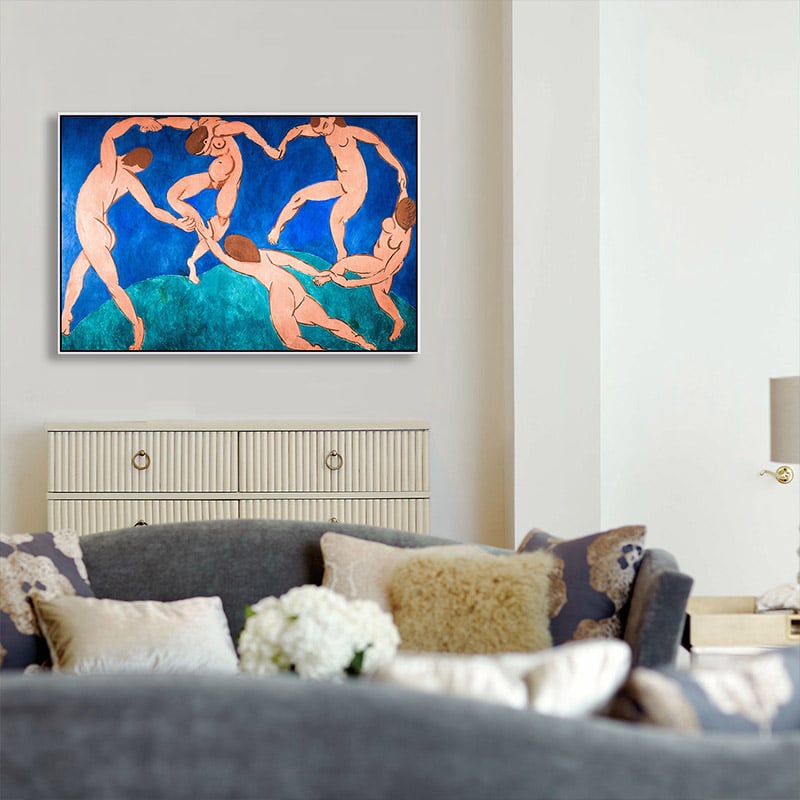
It makes sense to break this rule of how high to hang pictures over a sofa and other furniture … when considering space further, i.e., hanging exceptionally small or large pieces of art above the furniture. For example, a small work of art placed 15 cm above a long couch will not look balanced. In contrast, a large landscape format or a collageCollage refers to an art form where different materials are combined to create a single artwork. This technique often uses paper, fabric, photographs, and other found objects. It brings diverse elements together in a visually engaging way. History and Origin The concept of collage dates back to ancient times. Early cultures used materials like gold leaf and fabric in their More of art pieces will look great at that height. When in doubt about what décor art to choose, always opt for a larger-sized image and frame. It is much easier to fill your wall when there is less space to fill.
Some More Practical Tips
- To make things easier, you can trace frames on a paper and use painter tape in order to create a layout on the wall before you go ahead and put holes into the wall.
- Rather than lining up the bottom of a frame with elements of the interior architecture in your home or with other paintings, try to avoid perfect alignment. The overall appearance looks much less tense when lines are broken up.
- If you have a large-scale room with a long empty wall, you can try to break it up into several vignettes instead of considering the wall as a whole.
- When getting ready to mount your artwork, make sure to first get your picture hanging hardware ready. Besides measuring tape, a pencil, and a hammer, you will need the following: Get some small nails to hang pictures of smaller dimensions or light-weight art; Get picture-hangers for medium-weight pieces. How to hang heavy pictures? Get wall-plug anchors with fitting screws for your pictures hangers and a screwdriver for extra safety. How to hang pictures without nails? In case you want to hang your art on glass or on tile, you will need high-quality adhesive hooks instead of screws or nails – the easiest way to hang pictures. If you are mounting on a brick surface, opt for brick clamps.
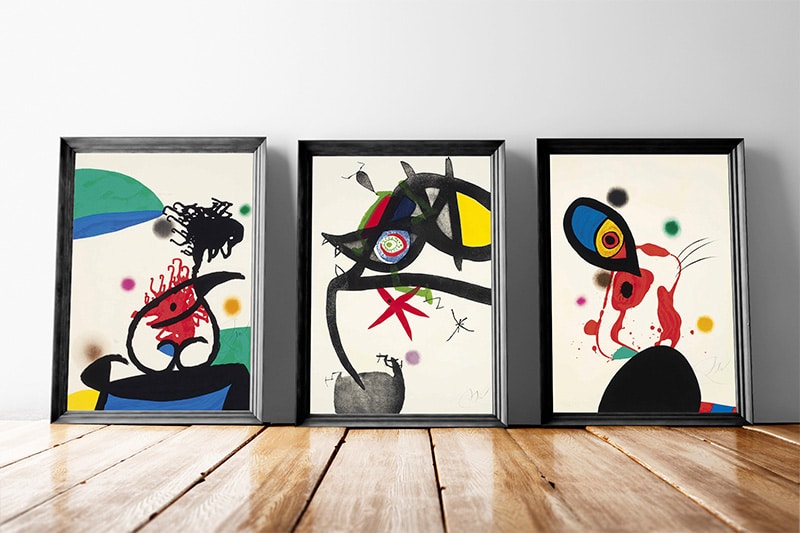
- Putting a nail into the wall for hanging a picture frame can be a scary thing – we do understand! If you are not up for hammers and nails, just lean your piece of art. You can lean a large piece simply from the floor against the wall or put it on a shelf. If you have a lot of hanging art in your home, some pieces leaning against the wall can be very refreshing, giving your modern house interior a casual look.
- There are more easy ways to hang pictures: If you want to spare your walls from holes and you like rearranging your artwork, a picture rail to hang picture frames will be ideal – this is how to hang a gallery wall which will look very professional! A sliver of moulding will be mounted near the ceiling, from where you can use wire to hang pictures with hooks. It is very easy to change your paintings whenever you want to, for example as part of your living room interior. Furthermore, the question how high to hang pictures won’t be as painful since it is very easy to make adjustments.
- An alternative, that also does not require any nails, is a picture shelf. This looks especially nice with smaller pieces of art and is open to rearrangements as often as you feel like it. An easy and fun way to show off some small-scale pieces is placing them in book shelves.
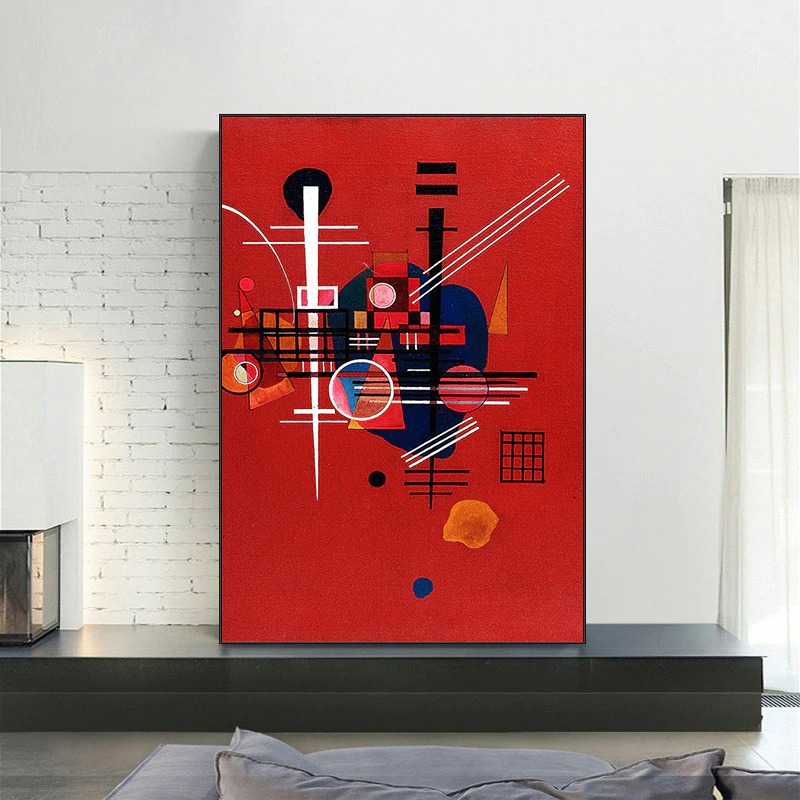
- It is not necessary to frame all your artwork for a successful home interior. Leaving certain pieces unframed, for example charming flea market artwork or paper sketches, can be an inspiring element in your bedroom interior design.
- You can not only mix and match when it comes to the pictures themselves, but also regarding frames. Good ideas to hang pictures can follow intuition. For example, match an extravagant vintage-style frame with classic styrene front frames on the same wall for an intriguing contrast. Framing can bring just as much style and personality to a space as the artwork itself.
- Does art on the wall require mats? This is entirely dependent on the piece of art itself. Sometimes a mat can lend importance to an artwork that otherwise would not have a strong impact. It is worth taking the time to play around and find out what is the best option for your piece.
- Some places in your home count as default spots for hanging art, such as art behind the couch, behind the bed, or above the mantel. For refreshing results, try hanging your art at unexpected places which are often overlooked, for example inside of a stairwell, at the end of a long hallway, or in the powder room.
Find out more about interior design rules with these classes from Skillshare. I have taken these courses myself and have gained great insights from them.
FAQ
How can lighting affect the way I hang art?
The right lighting can drastically change how art is perceived. Consider natural light during the day and install picture lights or spotlights for evening visibility. Balancing light helps highlight details in the art while avoiding glare.
How do I handle oversized artwork in small rooms?
Large pieces can overwhelm small rooms, but by positioning them strategically, they can create a bold focal point. Center them on empty walls, and pair with minimal decor to make the space feel bigger. Oversized pieces often add sophistication to otherwise simple rooms.
Can I combine mirrors with artwork?
Yes, mirrors can amplify the presence of art by reflecting light and adding depth to the room. Placing a mirror opposite artwork draws attention to both pieces, making the space feel more open. This works especially well in narrow hallways or small rooms.
How does texture influence an art display?
Texture adds dimension and interest, especially when mixed with smooth walls. Opt for framed textiles, textured canvases, or three-dimensional works to engage the viewer. This tactile contrast can enhance visual appeal and make a collection feel more dynamic.
How do art arrangements affect room flow?
A well-placed art piece can guide the eye and establish a room’s flow. For open-plan spaces, use art to subtly divide sections, like living and dining areas, without adding walls. The arrangement can also direct movement and highlight architectural features.
How does the color of a wall impact art placement?
Dark walls make bright artwork pop, while light walls suit subtler pieces or those with darker frames. Color theoryColor Theory is a comprehensive framework used to understand and analyze the use and interaction of colors in visual compositions. It serves as a critical guide for artists, designers, and marketers, helping them create harmonious and effective designs. This concept encompasses various principles and elements that dictate how colors are combined, perceived, and utilized. Primary Colors: • The three foundational More also plays a role: complementary colors in the artwork and wall can create harmony, while contrasting colors add vibrancy. Test different options to see how colors interact.
What role do shapes play in art placement?
Geometric art often works well in minimalist or modern rooms, while organic shapes suit eclectic or bohemian styles. The shape of the artwork should complement the surrounding furniture or architectural lines. This adds visual balance and coherence to the space.
How can I create focal points using art?
A bold or oversized piece naturally becomes a focal point in any room. To enhance this effect, keep surrounding decor minimal, allowing the artwork to take center stage. Focal points draw attention, setting the tone for the room’s mood and design.
How do patterns in artwork affect room design?
If the room already features patterned textiles, choose art with simpler designs to avoid visual competition. However, if the decor is minimalist, bolder, more intricate patterns in the artwork can energize the space. Consider balance between bold and subtle elements for harmony.
How does furniture arrangement interact with art?
Art and furniture should work together, not compete. For example, placing art too close to crowded furniture can make a space feel cramped. Allowing breathing room between furniture and wall art creates a more visually pleasing, balanced environment.
How do you consider scale when selecting art?
Scale is essential to avoid making rooms feel disjointed. Large art fits well in spacious rooms or on expansive walls, while smaller pieces suit intimate spaces like hallways or bedrooms. Ensuring the art feels proportional to the room’s dimensions is key to achieving balance.
Can I incorporate personal memorabilia with art?
Personal memorabilia, like travel souvenirs or family heirlooms, can complement art displays when curated carefully. Consider blending these items with professional artwork to tell a personal story. It adds a personal touch and makes the space more meaningful.
How do I choose the right color frame for artwork?
The frame should enhance, not overshadow, the artwork. Black or metallic frames tend to look modern, while wooden frames offer a classic feel. Neutral-colored frames are versatile and work with most art styles, but bold frames can add personality if chosen thoughtfully.
How can I create visual interest with asymmetry?
Asymmetry draws the eye by breaking from conventional symmetry. For a unique display, try placing a larger piece next to smaller ones, or slightly offsetting a central piece. This creates a sense of movement and keeps the arrangement from feeling too rigid.
How does ceiling height affect art placement?
In rooms with high ceilings, art can be positioned higher to fill vertical space and create a grand feel. Conversely, for low ceilings, keeping art lower on the wall draws attention away from the ceiling, making the space feel more intimate. Adjusting placement to suit ceiling height enhances the room’s overall proportions.



Mandala and Meaning: The History and Significance of Mandalas
The Psychology of Colour in Art: Masterpieces and Mind Games
You are still looking for a frame? Try GiftWorkPlus to get a custom frame!
